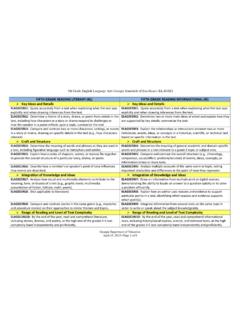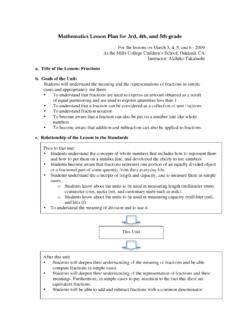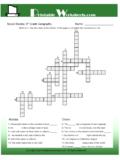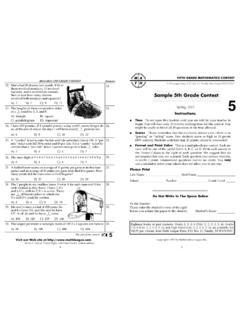Transcription of ELA Common Core Sample Questions - Grade 5
1 Grade 5 ELA 1 Common core Sample Questions The materials contained herein are intended for use by New York State teachers. Permission is hereby granted to teachers and nonprofit organizations or institutions to reproduce these materials for their own use, but not for sale, provided copyright notices are retained as they appear in this publication. This permission does not apply to mass distribution of these materials, electronically or otherwise. New York State Testing Program ELA Common core Sample Questions Grade 5 Grade 5 ELA 2 Common core Sample Questions Heidi by Johanna Spyri Five-year-old Heidi, an orphan, has just been taken by her Aunt Dete to stay with her grandfather, Alm-Uncle, who lives alone in a hut in the mountains in Switzerland. As soon as Dete had disappeared the old man went back to his bench, and there he remained seated, staring on the ground without uttering a sound, while thick curls of smoke floated upward from his pipe.
2 Heidi, meanwhile, was enjoying herself in her new surroundings; she looked about till she found a shed, built against the hut, where the goats were kept; she peeped in, and saw it was empty. She continued her search and presently came to the fir trees behind the hut. A strong breeze was blowing through them, and there was a rushing and roaring in their topmost branches, Heidi stood still and listened. The sound growing fainter, she went on again, to the farther corner of the hut, and round to where her grandfather was sitting. Seeing that he was in exactly the same position as when she left him, she went and placed herself in front of the old man, and putting her hands behind her back, stood and gazed at him. Her grandfather looked up, and as she continued standing there without moving, What is it you want? he asked.
3 I want to see what you have inside the house, said Heidi. Come then! and the grandfather rose and went before her towards the hut. Bring your bundle of clothes in with you, he bid her as she was following. I shan t want them any more, was her prompt answer. The old man turned and looked searchingly at the child, whose dark eyes were sparkling in delighted anticipation of what she was going to see inside. She is certainly not wanting in intelligence, he murmured to himself. And why shall you not want them any more? he asked aloud. Because I want to go about like the goats with their thin light legs. Well, you can do so if you like, said her grandfather, but bring the things in, we must put them in the cupboard. Heidi did as she was told. The old man now opened the door and Heidi stepped inside after him; she found herself in a good-sized room, which covered the whole ground floor of the hut.
4 A table and a chair were the only furniture; in one corner stood the grandfather s bed, in another was the hearth with a large kettle hanging above it; and on the further side was a large door in the wall this was the cupboard. The grandfather opened it; inside were his clothes, some hanging up, others, a couple of shirts, and some socks and handkerchiefs, lying on a shelf; on a second shelf were some plates and cups and glasses, and on a higher one still, a round loaf, smoked meat, and cheese, for everything that Alm-Uncle needed for his food and clothing was kept in this cupboard. Heidi, as soon as it was opened, ran quickly forward and thrust in her bundle of clothes, as far back behind her grandfather s things as possible, so that they might not easily be found again.
5 She 1 2 3 4 5 6 7 8 9 Grade 5 ELA 3 Common core Sample Questions then looked carefully round the room, and asked, Where am I to sleep, grandfather? Wherever you like, he answered. Heidi was delighted, and began at once to examine all the nooks and corners to find out where it would be pleasantest to sleep. In the corner near her grandfather s bed she saw a short ladder against the wall; up she climbed and found herself in the hayloft. There lay a large heap of fresh sweet-smelling hay, while through a round window in the wall she could see right down the valley. that could be defined for students are in bold. 10 11 Grade 5 ELA 4 Common core Sample Questions An important contrast in the story is between A Heidi s grandfather s concern and Aunt Dete s neglect B Heidi s old clothes and her new clothes C Heidi s former bedroom and her new bedroom D Heidi s cheerfulness and her grandfather s lack of emotion Key: D Aligned CCLS: Commentary: This question aligns to CCLS in that it asks the student to identify an important contrast within the story.
6 Rationale: Option D is correct. Both the point of view and the narration of actions highlight the two characters contrasting traits. There is no mention of Aunt Dete s behavior or any contrast between clothes or bedrooms. 1 Grade 5 ELA 5 Common core Sample Questions The narrator of the story helps the reader understand the grandfather by A describing his face and revealing his thoughts B describing his home and quoting his speech C telling Heidi s opinion of him and revealing his past D telling his emotions and showing his frustration Key: B Aligned CCLS: Commentary: This question aligns to CCLS in that it requires the student to understand how a third-person limited point of view (primarily aligned with Heidi) develops the grandfather s character. Rationale: Option B is correct. The grandfather is characterized through the things he says (dialogue) and the setting.
7 The narrator does not describe the grandfather physically, does not reveal his inner thoughts or tell about his past, and does not directly provide Heidi s opinion of him. 2 Grade 5 ELA 6 Common core Sample Questions When the grandfather says in paragraph 6 that Heidi is not wanting in intelligence, he means that she A seems to be a very bright child B says things she does not mean C impresses him with her knowledge D appears to misunderstand what he is saying Key: A Aligned CCLS: , Commentary: This aligns to CCLS and in that the question asks the student to determine the meaning of an unknown word or unusual phrasing ( wanting ) from context. Rationale: Option A is correct. Heidi s curiosity and her sparkling eyes provide evidence of her intelligence, and not wanting means not lacking. It is clear from the context that the grandfather does not think she is trying to impress him or that she lacks insight into what he is saying.
8 3 Grade 5 ELA 7 Common core Sample Questions How does the final paragraph contribute to the reader s understanding of the story? A It suggests that Heidi will make the most of her new surroundings. B It shows that Heidi will feel uncomfortable in her new home. C It indicates how poor the family is. D It shows how tired Heidi is. Key: A Aligned CCLS: Commentary: This question aligns to CCLS in that it requires the student to analyze what a particular portion of a text (the ending) contributes to the structure of the entire passage. Rationale: Option A is correct. The description of the loft, and of Heidi s feelings about it, reveal Heidi s happy adaptability to her new home. The final paragraph does not highlight discomfort, poverty, or tiredness. 4 Grade 5 ELA 8 Common core Sample Questions An American Hero: The Biography of C sar E. Ch vez C sar E. Ch vez was a good man who dedicated his life to helping others.
9 C sar was born to parents who taught him important ideas about hard work, the importance of education, and respect. As a young boy, C sar worked on his family s farm feeding and watering the animals, collecting eggs, and bringing water to the house.. C sar s parents were very strict and taught him and his sisters and brothers to show respect to others. His parents also taught him that it was important to help others. C sar and his family often helped his uncles, aunts, and cousins by giving them food when they had little to eat.. When C sar was ten years old, his family s home was taken away from them because they did not have enough money. C sar s family moved to California to find work. They began working on farms picking fruits and vegetables. C sar s family would move from farm to farm looking for work, just like many other families who also lost their homes.
10 Working on the farms was very difficult. Farm workers like the Ch vez family would work very long hours. They often had few bathrooms and little clean water to drink. Farm workers suffered a lot and they were not treated with respect or dignity.. C sar s family had very little money and many times they did not have enough food to eat. C sar and his family never thought of themselves as being poor. C sar s mother would often tell C sar and his brother Richard to find homeless and hungry men so she could cook them a meal. When C sar was a teenager, he and his older sister Rita would help other farm workers and neighbors by driving them to the hospital to see a doctor. Without C sar s and his sister s help, these people would have had a very difficult time getting a doctor s help.. A few years later, C sar volunteered to serve in the United States Navy.








